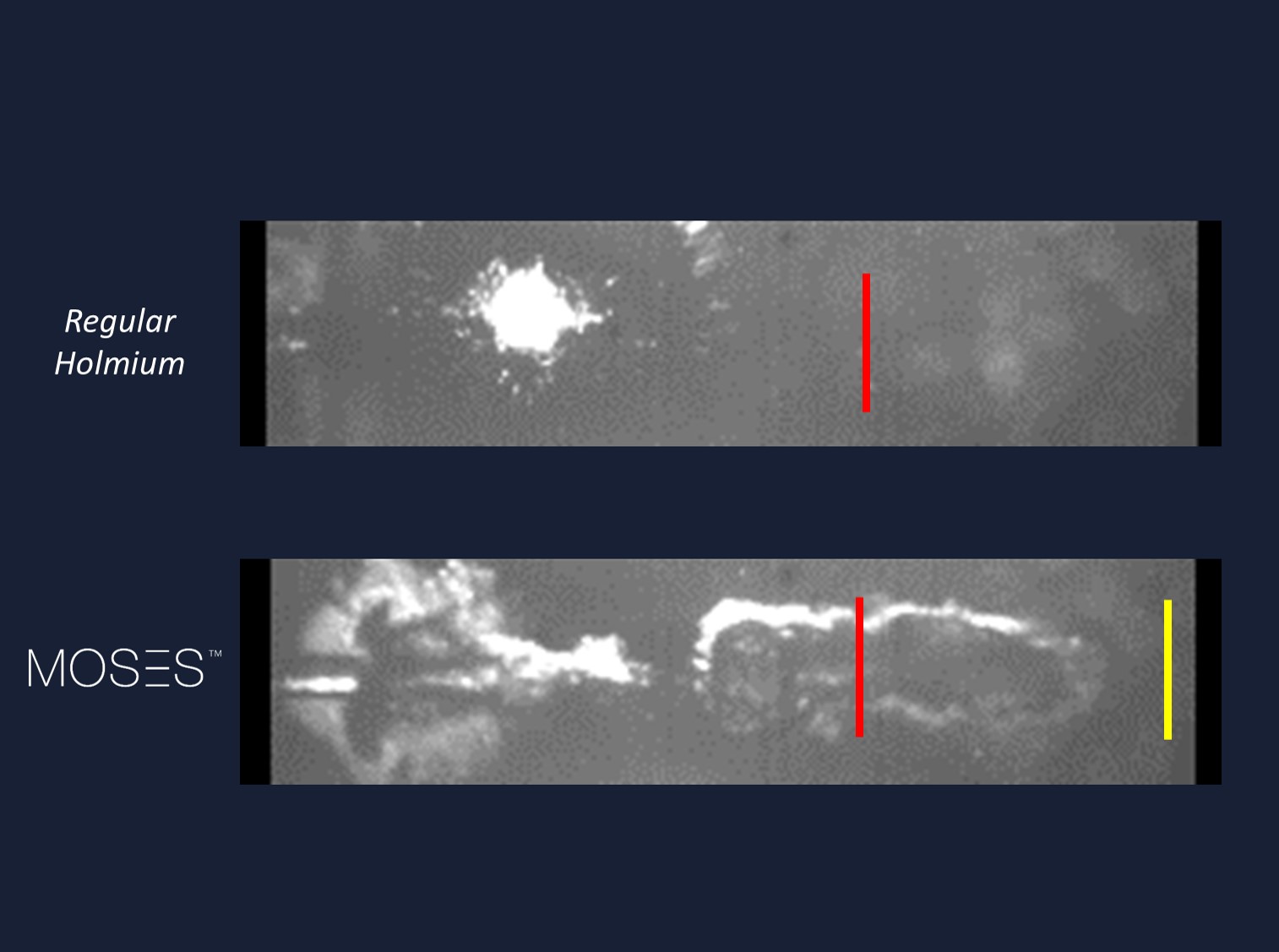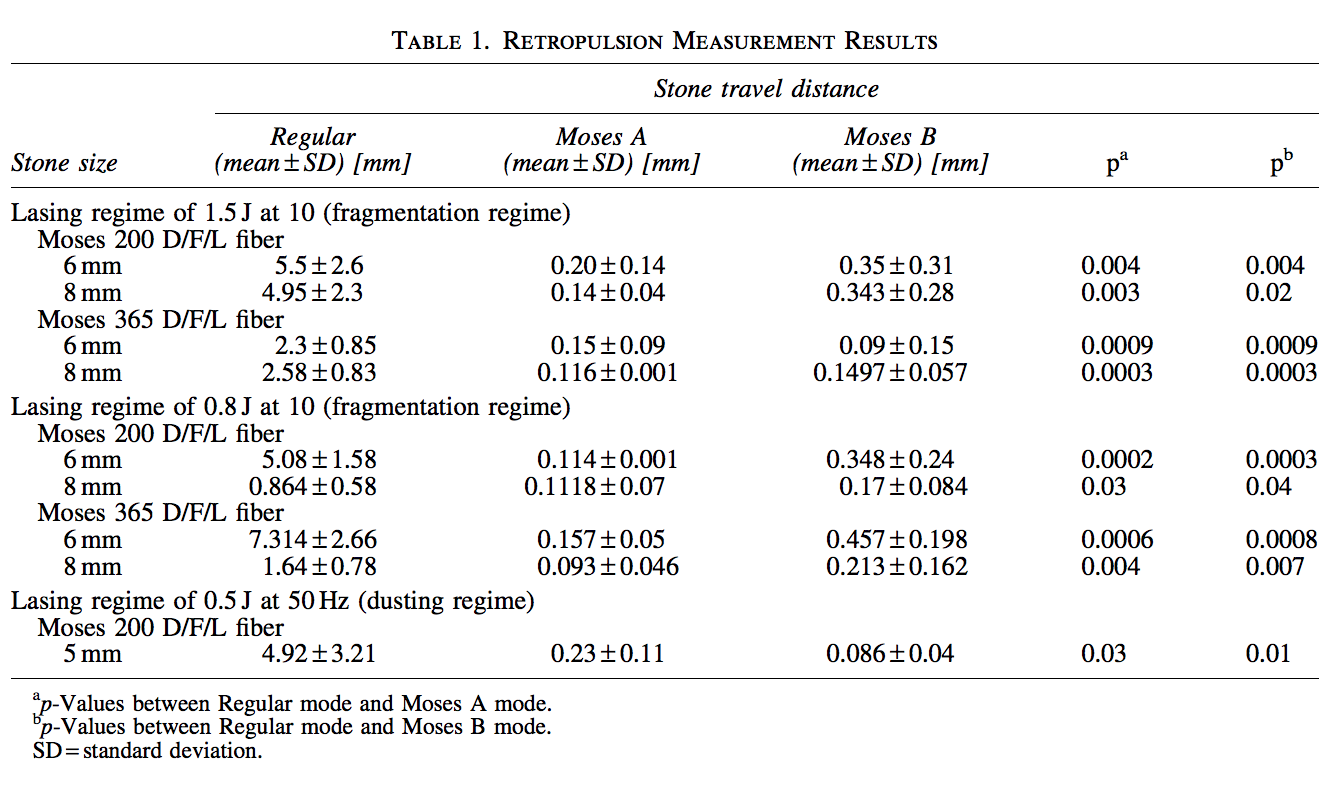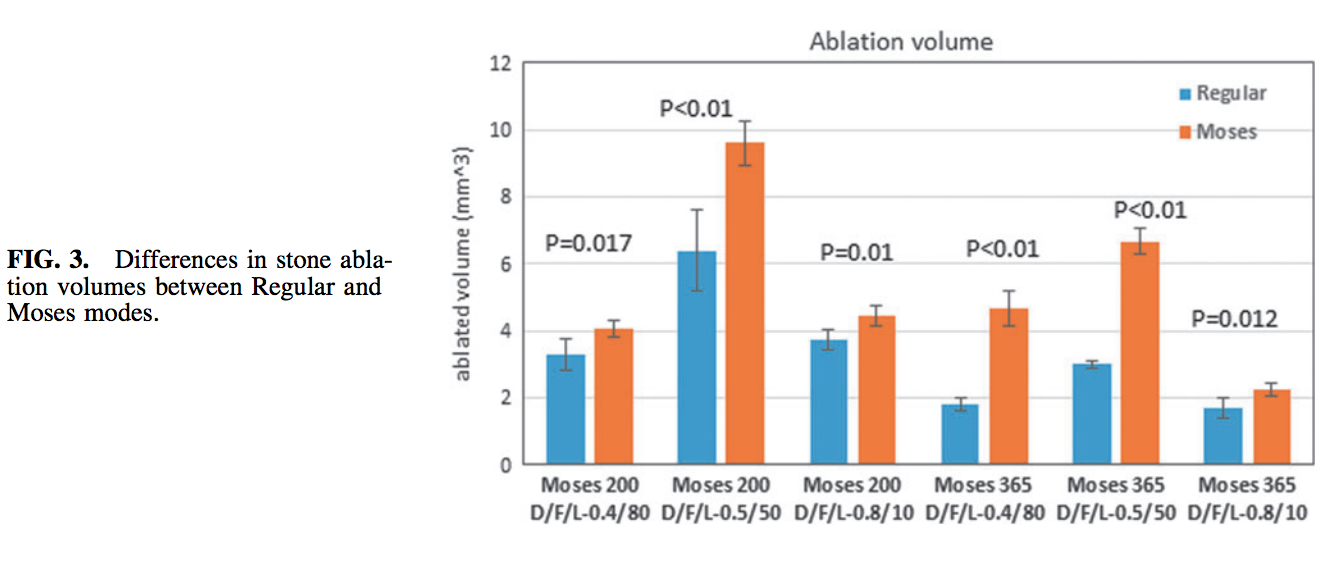With Moses Technology, the laser pulse is modulated into two consecutive parts. The first part separates the water by creating a small vapor bubble (“the Moses effect”), and then the remaining energy is transmitted via the vapor bubble toward the target. (Figure 1) The Moses Technology, which relies on both the Lumenis Moses Pulse 120 system and Moses D/F/L fibers, results in an efficient transmission of energy for stone lithotripsy. This reduces the dependency on fiber-stone tight contact for effective stone fragmentation, compared to standard holmium technology. Moses delivers optimized energy in two distances: Moses “Contact” mode, optimized for very short distances as in routinely used clinical scenarios, and Moses “Distance” mode, optimized for longer distances from the target (when full contact is not feasible, e.g. due to anatomical restrictions). Based on real clinical working distances, the two Moses modes allow the flexibility of choosing the appropriate mode for various situations.

Figure 1: The Moses Technology modulates the laser pulse into two parts: one that first separates the water by creating a small vapor bubble (“the Moses effect”), and a second that transmits the remaining energy via the vapor bubble toward the target.
My colleagues and I conducted preclinical comparisons and bench test analysis using the Lumenis Moses Pulse 120 holmium laser system, testing Regular mode (standard technology) vs Moses mode, with Moses 200 D/F/L and 365 D/F/L fibers. The Moses 200 D/F/L fibers had a ball-shaped tip with the purpose of minimizing the damage to flexible scopes during fiber introduction. The goal of the experiments was to comprehend how effective Moses Technology is in addressing current challenges faced by urologists during laser lithotripsy: stone retropulsion, lithotripsy efficiency (stone ablation), and ensuring the safety and usability of this new technology by studying tissue-laser interactions.
Stone retropulsion: To evaluate and quantify stone retropulsion, we placed targeted “plaster of Paris” stones on a jig. A fast camera captured the effect of the fired laser pulse on the stones, and we measured the stones’ movement away from the fiber using frame-to-frame analysis. We studied several combinations of stone sizes, fiber types, and laser parameters. We found that stone retropulsion was significantly reduced with Moses mode, compared to Regular mode, during the use of both fragmentation and dusting settings. A measurable reduction in retropulsion as high as 50 times less movement was recorded at selected settings (p < 0.01). (Figure 2)

Figure 2: Retropulsion Measurement Results
Lithotripsy efficiency: Lithotripsy efficiency was measured in terms of ablation volumes per energy. We followed a previously described model, measuring the ablated volume of a “plaster of Paris” plate placed in a water chamber under a motorized stage holding the fiber 1 mm away.3 Compared to Regular mode, Moses mode’s lithotripsy was dramatically more efficient, with an ablation rate up to 160% higher (p < 0.001). (Figure 3)

Tissue-laser interactions: We evaluated laser-tissue interactions by treating different soft tissues in both Regular and Moses modes. Treated tissues were dissected and sent for repetitive microscopic histological analysis. The tissue impact, primarily the thermal damage as represented by the coagulation zone, was measured for each mode. For this analysis, we used a unique in vivo porcine model for ureteroscopy and lased on the ureter wall in near contact, mimicking accidental lasing in different dusting settings. Tissue analysis showed that the Moses mode had a narrower, more concise incision pattern than Regular mode. Moses mode seemed to cause less damage at the margin than Regular mode, at settings of 0.3J/80Hz ( p < 0.05), and there were no significant differences at 0.4 J/50 Hz. In an additional setup utilizing ex vivo lasing on porcine bladder tissue, there were no significant differences between Regular and Moses modes in terms of the coagulation margins and tissue damage. Therefore, the Moses mode did not raise any new safety issues compared to the Regular mode.
Based on the outcomes of these experiments, we concluded that the Lumenis Pulse 120H with Moses Technology addressed two primary challenges associated with standard holmium laser lithotripsy: it significantly reduces stone retropulsion and shows an enhanced efficiency. It does so without raising any new concerns or adding safety issues. As a result, we think that new Moses Technology presents an advancement in stone laser lithotripsy that will result in shortened procedure time and better treatment outcome. Initial clinical evidence using the Moses Technology supported these notions, showing significant reduction of stone retropulsion and better physician control. Moreover, Moses Distance mode was used to efficiently treat stones in challenging locations that are poorly addressed by standard holmium devices. Additional studies including a randomized trial are currently being conducted to confirm these results.
Written by: Shadi Badaan, MD
Shadi Badaan, MD, is an attending physician in the Department of Urology at Rambam Health Care Campus in Haifa, Israel.
References:
1. Turk C, Petrik A, Sarica K, et al. EAU guidelines on interventional treatment for urolithiasis. Eur Urol 2016;69:475–482.
2. Ordon M, Andonian S, Blew B, et al. CUA Guideline: Management of ureteral calculi. Can Urol Assoc J 2015;9:E837–E851.
3. Kronenberg P, Traxer O. In vitro fragmentation efficiency of holmium: yttrium-aluminum-garnet (YAG) laser lithotripsy: A comprehensive study encompassing different frequencies, pulse energies, total power levels and laser fiber diameters. BJU Int 2014;114:261–267.
Read More:
Study: Elhilali, MM, Badaan S, Ibrahim A, Andonian S. Use of the Moses Technology to Improve Holmium Laser Lithotripsy Outcomes: A Preclinical Study. J Endourol. 2017 Jun 1; 31(6): 598–604. Published online 2017 Jun 1. doi: 10.1089/end.2017.0050
Read the Abstract
Ureteroscopic Holmium Laser Lithotripsy Using the Moses Technology


